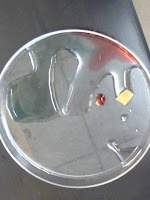 For the Crime Scene Investigation, I was assigned to Scene 1 with seven other people. Once we "arrived at the scene," we each took one or two of the eleven pieces of evidence to analyze. I had the footprinting clue, where there was what looked like the bottom of the victim;'s shoe and and image of a shoe-print that was pointed in the direction away fromt he crime scene. Below is all of the information and analysis of the clues:
For the Crime Scene Investigation, I was assigned to Scene 1 with seven other people. Once we "arrived at the scene," we each took one or two of the eleven pieces of evidence to analyze. I had the footprinting clue, where there was what looked like the bottom of the victim;'s shoe and and image of a shoe-print that was pointed in the direction away fromt he crime scene. Below is all of the information and analysis of the clues: Background Information:
A dead body was found decaying in an open field by the woods.
Analysis of Clues:
Exhibit 1: Handwriting: Forged suicide note: "Please forgive me. I do love you all."
: Characteristics include large loops, semi-connected letters
: Note: Handwriting changes throughout the note, the victim DID NOT write it.
Exhibit 2: Hair: Caucasian, short (boy?)
Exhibit 3: Fingerprint: Plain arch
Exhibit 4: Poison: pH between 7-8, cocaine tested positive.
Exhibit7: Footprinting: Shoe found on victim's foot: height: 6 7/8 inch
: Width: 4 inch
: Looks like an athletic/running shoe. It s very small, which leads me to believe that the victim was a child, most likely a boy.
: Suspects foot/shoeprint: Height: 11 inch
: Width: 4"
: It is an athletic/running shoe. The size and type of indicates that the person who committed the crime was most likely a man. The print was found walking away from the scene.
Exhibit 8: Lift Print: The fingerprint found on the scene was an ulnar loop.
Exhibit 9: Fingerprint: Another print found on the scene, a double loop, possibly the victim's.
Exhibit 10: Fiber: Black, long string. Under the micrso scope it looks like nylon.
Exhibit 11: Syringe: Could have been used to drug the victim.
Possible Suspects:
After our analysis of the clues, we identified three possible suspects as Courtney Smith, Jet Trong, and Lucas Moore. After further analysis, we determined the perpetrator to be Lucas Moore because of the finger prints, footprints, handwriting, and facts about him.
The Final Story:
Lucas Moor's wife divorced him, and took his young son with her. Soon after he fell into a deep depression, went crazy, and was admitted into a pchysiatric ward. He broke out and stole cocaine. He left a suicide note for the mother, planning to take his child. He waits in the woods for his son to pass by on his way home froms school. Spotting his son, Moore jumps out of the woods and tries to take the boy. The child fights back, which explains the missing tooth of the victim and the handful of short, caucasian hair. Moore tried to drug his child, but accidentally killed his son during the stuggle, so he left his son on the field by the edge of woods and the fled the seen.














